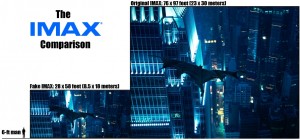Frequent commenter “Mahkno” mentioned in response to a previous post that “IMAX was [as of the last time he looked into it] moving away from the singular movie theatre venues. Their principle growth has been in partnering with large theatre chains to sell their IMAX brand, equipment, and format. It might be more likely at this point that one of the area multiplexes would adopt the IMAX format before the museum would.”
As a matter of fact, IMAX has indeed been partnering with large theater chains, including Goodrich Quality Theaters (which owns Willow Knolls 14 in Peoria) and AMC (which will soon own ShowPlace 14 in Pekin). But these multiplex IMAX theaters are not the same as standalone IMAX theaters. They’re smaller. A lot smaller. In fact, here are a couple of screen-size comparisons that I’ve shamelessly swiped from other websites (here [WARNING: lots of profanity] and here):
Click on the images to enlarge. As you can see, the retrofitted multiplex theaters don’t really hold a candle to a true IMAX giant-screen experience. But that really isn’t what has gotten everyone so upset. After all, the screen is larger than most multiplex screens, and the sound is far better.
What bothers critics — including Roger Ebert — is that IMAX is not differentiating these smaller theaters from their traditional giant-screen theaters. So Joe Blow goes to his local AMC multiplex and plunks down an extra five bucks for the IMAX experience, walks into the theater and… surprise! It’s not a giant-screen theater, but just a slightly-larger-than-average multiplex theater screen. And he feels scammed. Ebert offers some common-sense advice:
But apparently, IMAX is not going to do any such thing. This whole outrage over what many are calling “fake IMAX” broke out nearly a year ago, and so far no differentiation has been forthcoming from IMAX.
Nevertheless, given AMC’s deal with IMAX and the fact that AMC is buying Kerasotes Theatres, I wonder if the museum might have some competition for landing a local IMAX theater. Time will tell.

![screencompa[1]](http://peoriachronicle.com/wp-content/uploads/2010/02/screencompa1-300x218.jpg)

CJ… IMAX does differentiate but most folks really don’t understand it.
1) IMAX Dome / IMAX Dome 3D / Omnimax – this the the semi hemispherical shaped theatre that is iconic to the IMAX name. This is what is in the Museum of Science and Industry up in Chicago and in Des Moines. Films made for this format require special equipment which amounts to shooting the film twice if you are making a normal version alongside.
2) IMAX – This simple label just means there is a really large mostly flat screen. There isn’t any real growth in this format. Movies are in 2D
3) IMAX 3D – like #2 it is a large mostly flat screen. There are 3 different sizes but the big money is in the smallest MPX/Digital size being marketed out to multiplex theatre operators. Hollywood likes the new digital format for the smaller size because they can more readily and cheaply make IMAX copies of the movies they shoot. Kind of like how Blu Ray players can upgrade DVDs to 1080p.
So there you go… IMAX Dome and IMAX 3D. If the word ‘Dome’ is missing… it isn’t a dome but could be cool nonetheless. Yes, as Ebert notes, IMAX doesn’t really distinguish among the flat screens very well.
I think the public’s confusion stems less from variations in flat screens and more in the difference between flat and dome. They just see IMAX and expect a dome. When it isn’t there … well. The museum group has been deliberately vague as to which format they are seeking. The IMAX brand is being diluted into the “slightly-larger-than-average ” format but a company has to do what it has to do to survive. The Domes simply were not and are not profitable despite their cool factor.